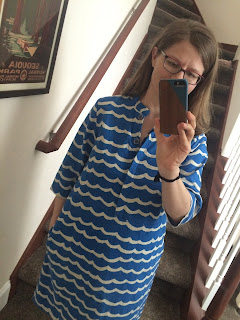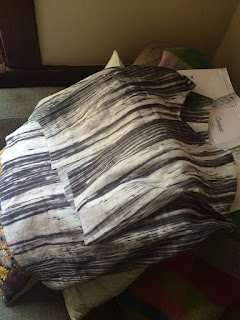Here is a skeptical face with my newest self-made frock. It's my third Laurel, by Colette Patterns, and despite the expression I'm sporting, I'm relatively pleased.
The Laurel is a relatively basic sheath dress that is a great use for fun fabrics. This one is a Cotton and Steel quilting cotton that I lined with a kind of fuschia/magenta in order to give it better drape and to make it nice and soft and slinky on the inside. (Sarah Watts, Cat Lady, Purrfect Hiding Spot)
These are cut relatively short, so they fall a few inches above the knee for me, which is perfect for wearing with leggings (ie, my favorite outfit combination.)
As I mentioned in the instagram post about this dress, I totally forgot to add my custom pockets. I used french seams to close all of the seams, so at least for now, I'm just going to leave it pocket less. I'll be honest though, having pockets is like half of the point of making your own dresses, so I may find the time to undo and add them back in.
The Laurel uses bias tape to bind the sleeve and neckline, but as I'll discuss in a minute, I don't like that look, so I used the bias tape to instead creating a folded seam for the neckline. There is probably a more official way to say this. Though this worked perfectly on a Laurel top I'm gifting to my mom, you can kind of see in this picture that the neckline is basically perpendicular to my body. This is not how necklines should lie. Again, we'll see if I do anything about it. Maybe it'll loosen up after a wash?
Just finished this, so no notes on wear yet, though.......
Below is my second Laurel. I LOVE this dress and would wear it all of the days. I installed the sleeves upside down, and I really don't like the bias tape as binding for the neckline and sleeves. It's hard to sew and capture both sides, and my stitching loops sloppy and therefore more homemade. Also, anyone who can point to a ready made garment that uses bias tape like this wins a prize, because I don't think it happens.
Despite all of those criticisms, as I said, I looooove this dress. It's black and white, so I feel like it's 100% work appropriate, but it's another Cotton and Steel by Alexia Marcelle Abegg, and while it's name is kinda of eh, I think I read a description of it as being 'all of the things you would find in a magical barn', so I call it my magical barn dress. Yes, there are rabbits, of course.

Not picture are:
1) my very first Laurel, which might have been a second or third dress? It was a wearable muslin I made with maybe 2 yards, but maybe less of a green corduroy I had purchased to make a skirt. That's the other thing great about this pattern! It's only a few pieces (front, back, sleeves, bias binding), and it's light on fabric I like it, and have worn it belted and not belted, but because the dress and styling are so plain, I do like the print version better - more visual interest.
3) A Laurel top I made that my mom will receive when I remember to go to the post office. I used HEB's old curtains, and it's light and airy and I quite like the shape. I was trying to test out how to do a Full Bust Adjustment, and used bad instructions, so I decided to just make the top normally, but then forgot to readjust the sizing. Ah well, nice to give my mom a handmade top. But I would put the Laurel top on my sewing list for tops. Nice length and decent visual interest.
OH, and a note on these - I did an invisible zipper for the two pictured, without an invisible zipper foot, but using this tutorial, and found it very easy both times. Highly recommended.
























































